11 checks to make before your classic’s first spring drive
With warmer weather finally arriving in many parts of the country, spring driving season is once again upon us. This article originally published in 2020, but these checks were as relevant then as they are today. Here’s to many more miles this year! –Ed.
If you’re reading this, you almost certainly have a non-daily-driven enthusiast car somewhere in a locked garage. It’s time to unlock the door, let that puppy out, fire it up, and drive it.
But you need to check a few things first.
I assume that the car has been sitting over the winter—say, three to six months. If the car’s been sitting for years instead of months, you get into a whole other level of issues like bad gas, clogged fuel lines, corroded cooling-system components, and failed brake and clutch hydraulic seals. But for a season’s sit, the list below should be pretty good.
Enabling the rollout
The cars that I store offsite are in rented, traditional, one-car-per-roll-up-garage-bay spaces and thus can be brought out at a moment’s notice, but at my house I have a shoebox-proportioned garage with a single door into which four cars are stuffed in two rows, nose-to-tail.
The car immediately behind the door can be pulled out easily, and the one behind that (on the mid-rise lift) is next in line, but the other two are typically blocked in by a winter’s worth of tools and parts.
Once that Maginot Line is cleared, I need to slide a car to the right on wheel dollies. This turns my space from a four-car, winter garage to a three-car, three-season garage, which it remains until first snow. It also means that one formerly garaged car must go somewhere, creating a chain reaction that sets off a shuffle in the other places where I store cars.

Tires
If, when you roll open the garage door for the first time in months, one of your car’s tires is wheel-on-the-cement flat, you kind of have to start with the tires, so let’s. Obviously, if that’s the case, you need to air that tire up before you can move the car. If you don’t have an air compressor in the garage, buy a portable one that runs off the cigarette-lighter socket, or better yet, runs off 12V DC or a 120VAC adapter.
I’ll air up the tire and then see what it’s going to do. If you immediately hear it hissing from a puncture or a bad valve stem, then you need to stop everything, jack up the car, pull the wheel off, and either swap on another wheel and tire or get this one fixed. But if you don’t, you can see whether the leak deflates the tire over hours or days. Just remember that it deflated over the winter, so it’s going to do it again.
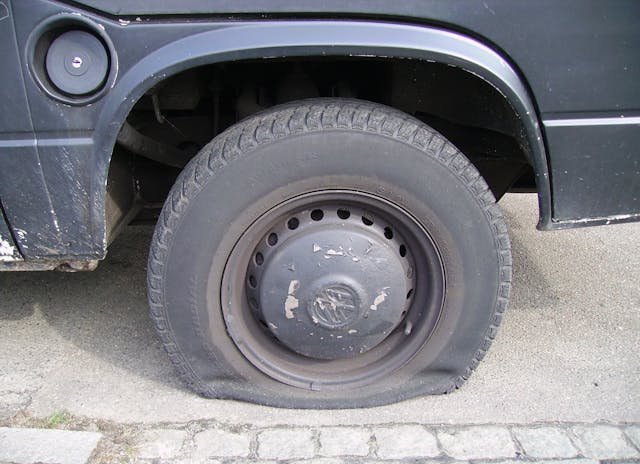
Then, check the air pressure of all four tires. While you’re doing that, it’s a good idea to inspect the tire sidewalls for cracking. Odds are that if the car is stored indoors, the tires aren’t going to get much worse over a single winter, but it’s easy for 10 years to go by one winter at a time and the tires to cross from old-but-OK to sheeh-I-don’t-want-to-drive-farther-than-to-the-gas-station-on-those.
Battery
We’ll come back to the battery in cranking (below), but here’s where I talk about what you should’ve done when you put the car away last fall. If the battery has been on a tender or trickle-charger for the winter, it’s probably fine. Since I store several of my cars in a remote garage without electricity, I can’t trickle-charge them, so instead I simply unhook the negative battery terminal over the winter. Most of the time, when I reconnect it three or four or six months later, the engine turns right over.
But if you didn’t do either of these things, you’ll probably have a problem.
You can take a multimeter, set it to measure voltage, and put the two probes on the battery terminals. If it reads 12.6 volts, or near it, the battery is fully charged, and if it’s in good health and the cable connections are good, it should turn the engine over. But with every 0.2-volt drop, the battery loses about 25 percent of its cranking power, so if it’s reading closer to 12 volts than 12.6, it’s is unlikely to crank the engine over without being connected to a good three-stage charger for several hours. So measure the battery’s voltage, and if you need to charge it, charge it.
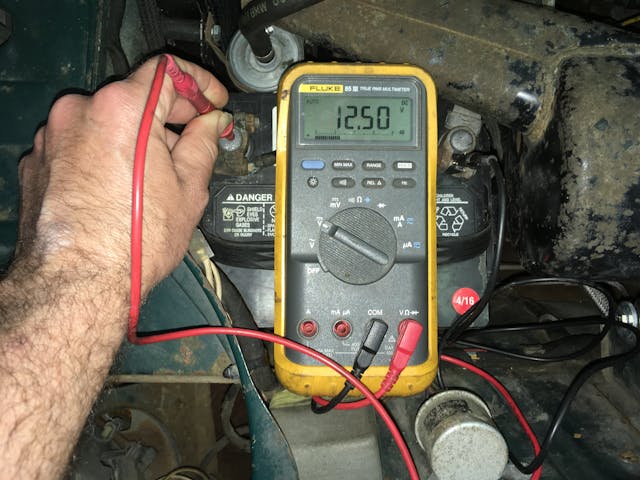
Fluids inside
Check the oil, coolant, and brake fluid levels. I’m pretty bad at keeping track of which car had an oil change when, so I do it more by the seat of my pants. If the oil looks black, I make a note to change it soon. I give a quick look inside the radiator or expansion tank to both check the level and see if there’s any oil in there indicating a weakening head gasket.
Fluids outside
Next, look under the engine compartment for evidence of leaks. Hopefully all you find is a few dots of oil from where the car’s been leaking out the front timing cover for the last 40 years and nothing more.
Anything green is antifreeze, and its source should be identified before you drive the car, as a minor leak can quickly mushroom into a gusher. Blue liquid can be either antifreeze or washer fluid. Clear liquids are usually power steering or brake fluid. I’m not above doing the pinky-in-the-fluid-and-tongue-touch-to-the-pinky test (antifreeze is sickly sweet), but I’m old and cannot be easily killed.
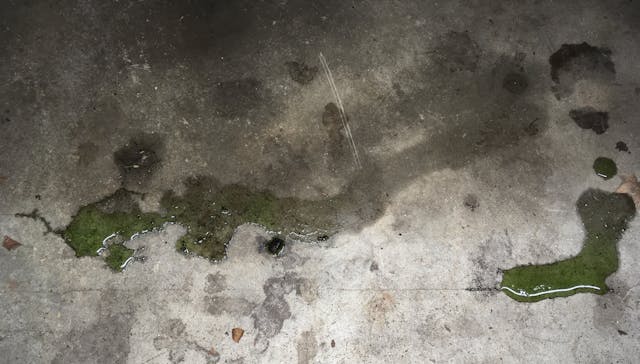
Move to the back of the car where the fuel tank is, schooch under, look, and sniff. Vintage cars have metal fuel tanks, and they can leak from age, particularly with ethanol’s propensity for attracting water. Since it’s good practice to store a car with a full tank of gas (this eliminates the chance for humid air to get into the tank and contaminate the gas with water), if you find the tank leaking, it ruins your day, since you now need to drain it. Gas can also leak from rotted or cracked rubber fuel lines.
Gasoline isn’t like oil or antifreeze; there should be a zero-tolerance policy for any amount of fuel leakage. You should also sniff in the engine compartment to be certain gas isn’t leaking there.
The critter check
If your garage has an affinity for rodents and they’ve made your car home, they can deposit a lot of material in the air cleaner in a short amount of time. It’s good insurance to pop the top off the air cleaner and have a quick look.
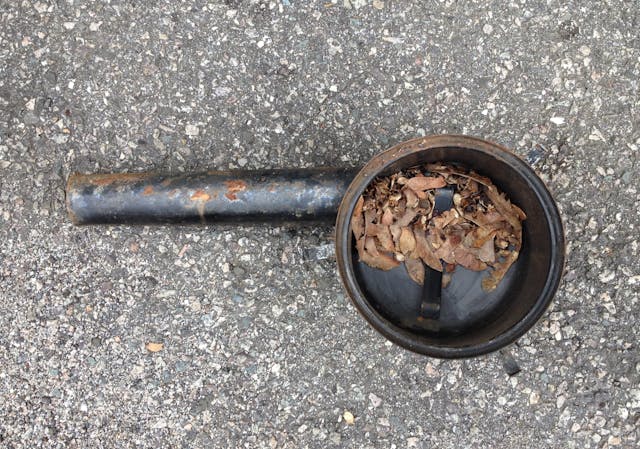
Hoses and belts
Give the hoses and belts a quick inspection. Squeeze the hoses. If any of them are pillowy soft, order replacements. Inspect the belts for cracks and cuts and put a thumb on each of them to check the tension. If they’re obviously loose, take a moment and tighten them.
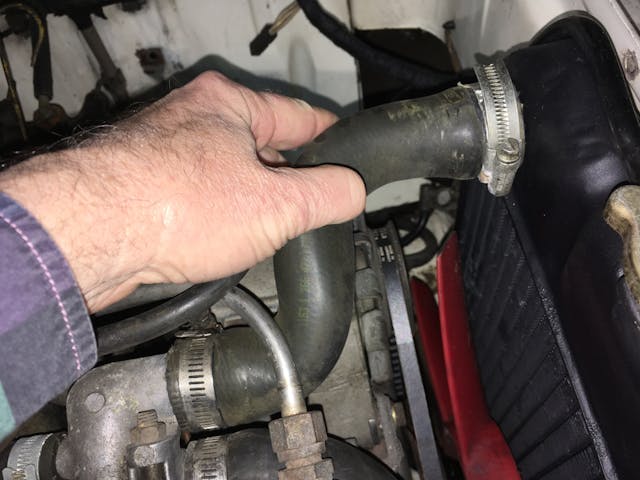
The crank-over
If the car has passed the above checks, the engine is ready to be cranked. As I said above, if the battery is fully charged and registering about 12.6 volts, it should crank when you turn the key. If it doesn’t crank, clean the battery and cable terminals and try again.
If the voltage is a little low, you can jump-start the car, but if the battery is deeply drained (turn the key and you get a click of the starter but that’s all), or worse, flatlined (less than 10.5 volts, or the car’s dash lights barely even turn on), it’s best to replace it before you drive the car. Alternators aren’t designed to charge deeply discharged batteries. Although old analog cars often don’t seem to mind, post-OBDII cars with a proliferation of electronic control modules can do very odd things, including bucking and dying, if a deeply discharged battery is jump-started and the car is driven.
If the car is fuel-injected, it will likely start in just a few seconds when the starter is cranked. If it doesn’t, the fuel pump may not be running, either due to a popped fuse, stuck relay, or the pump itself.
Carbureted cars often take much longer to start due to the lower fuel pump pressure, the need to refill the float bowls, the far less precise air/fuel metering, and the lack of direct spray into the cylinders. A short blast of starting fluid into the carburetor throat can coax the engine to life. If a carbureted car still won’t start after sitting, the problem is often that an old fuel line has become dry-rotted and is sucking air rather than fuel.
The eyeballs-on idle
Once the engine is running, let it idle for about a minute. Then shut it off and look under the engine for any fluid dripping or streaming out.
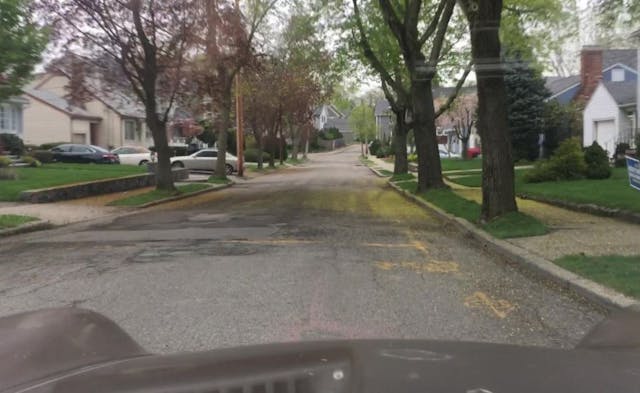
Twice around the block
It’s common for brake pads to stick to rotors from sitting. If the car has been stored indoors, the rotors probably won’t have rusted much, but still you want to scope it out. Take the car for an easy lap around the block. Brake gently to verify that the brake pedal is firm and functional, then more firmly. Pick up speed and do it again. Note any brake-pedal shudder (pulsation), pulling to one side, or steering-wheel shimmy. Pull back into the driveway and check again for any fluid leakage.

A real test drive
Take the car up onto the highway or other road where you can build speed. Verify that it comes up to operating temperature in about the middle of the gauge and stays there. Continue to test the brakes for shuddering or pulling. If the brake pedal is still pulsating, there are still unwiped deposits on it. A series of hard braking exercises (first verifying that no one is behind you) may wipe the rotors clean, or you may find that it doesn’t go away and you need to buy new rotors.
If there’s steering-wheel shimmy that wasn’t there in the fall, it’s likely the tires are flat-spotted from sitting. It may go away. It may not. Come home, recheck for fluid leakage, and check again the next morning.
If the car passes these tests, I feel pretty good about thinking that it’s in about the same condition it was in when put away in the fall and I’m ready to begin to enjoy it in the spring. But keep in mind that successfully emerging from storage doesn’t mean that the car has been healed of any known problems. Cars are not biological systems; they don’t mend themselves with a good long sleep.
***
Rob Siegel has been writing the column The Hack Mechanic™ for BMW CCA Roundel magazine for 34 years and is the author of five automotive books. His new book, Resurrecting Bertha: Buying back our wedding car after 26 years in storage, is available on Amazon, as are his other books, like Ran When Parked. You can order personally inscribed copies here.
Check out the Hagerty Media homepage so you don’t miss a single story, or better yet, bookmark it. To get our best stories delivered right to your inbox, subscribe to our newsletters.
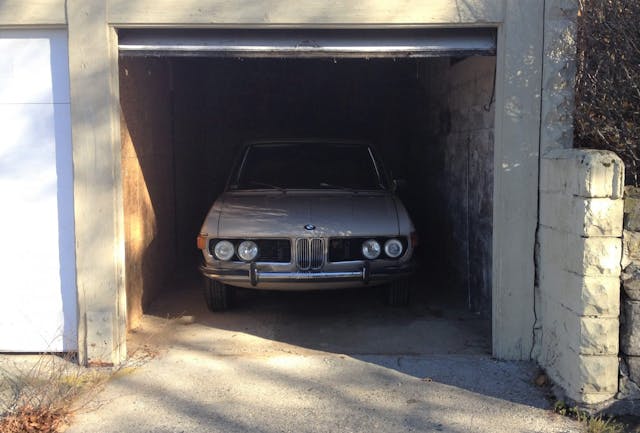
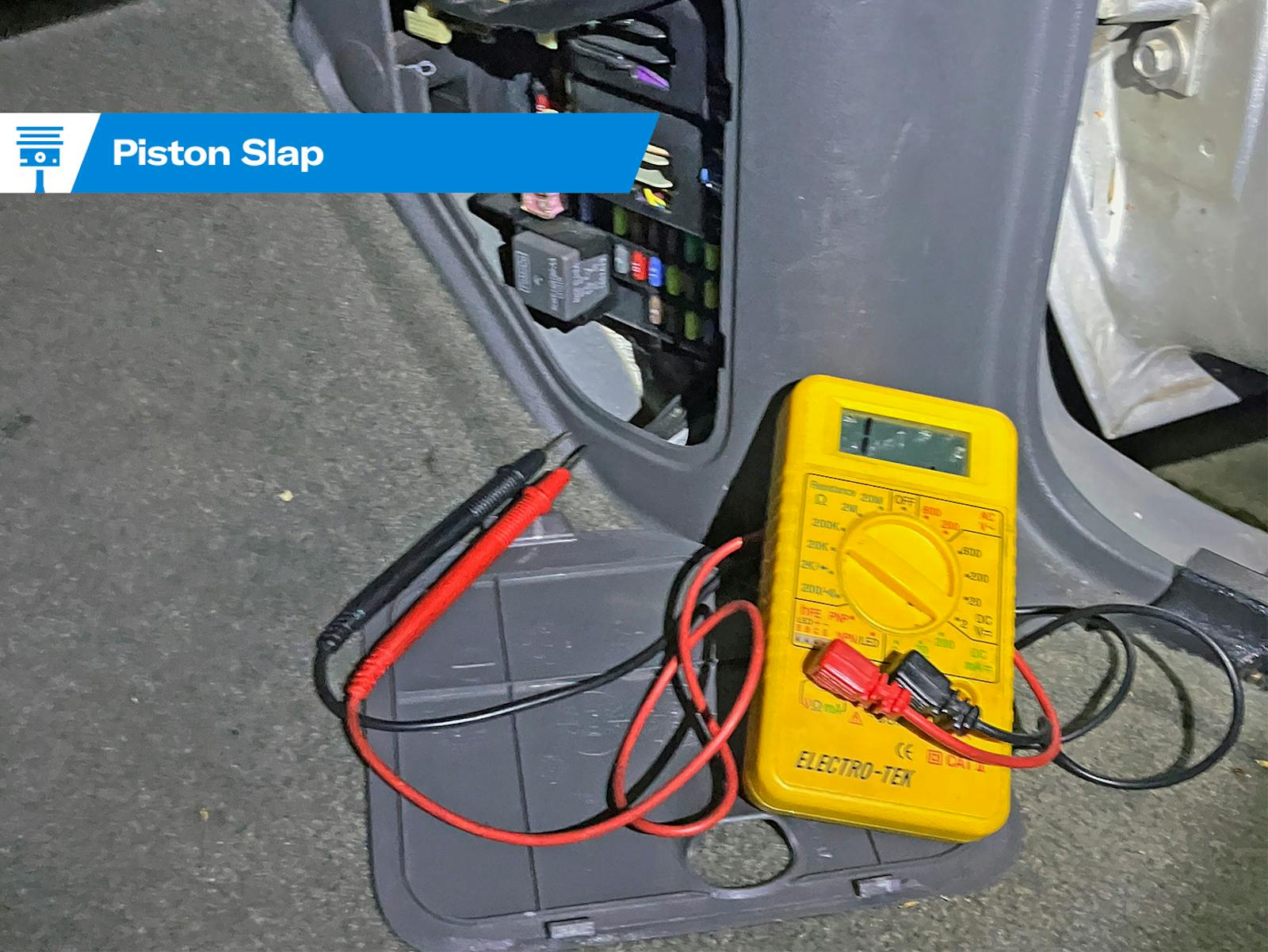

I always inflate the tires on my stored cars to the maximum pressure noted on the sidewall to prevent flat spotting. So far, it’s worked quite well. I also put a Post-It note on the windshield or driver’s door telling me to check the air pressure and remove the dryer sheets under the hood placed to prevent rodents. Don’t know if it really works but so far so good.
OK – Two things to do when putting your vehicle away:
One – slip some caps on the exhaust pipes to keep rodents from building nests or storing food in your mufflers and pipes. They can put nuts, etc, deep enough into the muffler that they can’t really be blown out. Use a loose fitting cover so that when starting after storage (by then you will no doubt have forgotten that they are there and, besides, that will be the furthest thing from your mind at that point) so that they will blow off when engine starts. Of course, if your outlets are not conducive to covers, you could use a different method to secure the outlets (Al foil?).
Two – Another cover-up job: Put wire mesh covers on your air intake(s). Regular screen wire is too fine for this if you leave it on all the time like I do. I use wire mesh screen (Google “wire mesh screen”) with square openings about 3/8 inch.
I remember an episode of Barnfinders where a low mileage beautiful 1957 Olds Starfire convertible was being brought out of its Rip Van Winkle sleep when they found the engine was seized. Upon removing one of the cylinder heads they discovered that some critter had entered the exhaust system gone through an open exhaust valve and had made itself a home. As the camera zoomed-in you could see what an incredible mess that critter made out of that cylinder.
The author evidently has too many cars, forcing him to neglect some of them.
Just for starters, I would never put a car away for storage with black oil. Nor would I forget to fill up the gas tank, use a fuel stabilizer, pump up the tires or hook up a battery minder.
I do a weekend-long maintenance routine for each of my cars before putting it away in the fall: oil and filter, fluid check, thorough deep-cleaning in, out and underneath, and wax, along with the aforementioned gas top-up and trickle charger.
The added benefit of doing this maintenance BEFORE you store the vehicle is that come springtime, just a few quick checks and you’re good to go! Also, since you’re doing it annually there’s less to remember.
Tires – I always pumped them up to 50 lbs for winter storage to avoid Flat Spotting
This spring roll out said to check oil and “if the oil looks black, make a note to change it soon.” I agree that black oil needs to be changed but I always keep an index card in the car that eliminates visual or guess work. this has the date, millage, oil type. Also other info can be there such as filter number, oil capacity, plug wrench size and reminder of filter location if needed as some are hard to find. And on a final note, oil should be changed just before any motor is put in storage. I have been told, [ I have not personally checked for PH ], that dirty oil can have an improper PH level that can be damaging to gaskets and such even when stored. Also if changed before storage there is one less thing to do when spring roll out comes. leave yourself good before storage, for more reasons than one.
Starting the engine: carb vs fuel injection. My fuel injected cars take a couple seconds to start. My ’76 Vette, after sitting in the garage for 5 months, with no attention, fires up immediately as soon as the key touches ‘start’. To get the oil pressure up, I just put the accelerator pedal to the floor and turn the key. Engine will turn over, but not start.
I agree with Tom Wasney. You cannot tell me that the roads in your area are completely covered with crap all winter long. I don’t care where you live, there’s going to be some clear dry weather that you can get your car out & drive it during the winter. I live in Tn & have a ’57 Ranchero, “32 Ford Hiboy, & a”51 Buick woodie & all 3 get periodic exercise runs during the winter. We don’t get that much snow or salt, but once the roads have been run on for a day or 2 after bad weather, the amount of crap off the road you might pick up is minimal. And if you’re really worried, you can always hose off the wheel wells when you get back. DRIVE THE CARS!!!
Come to where I live. The roars are covered with SALT all winter long.
Yes, Here in CT we had an extremely mild winter this year… but they did put down salt repeatedly, just in case all winter. The roads have salt and sand until the spring rains wash the roads, and the town crews sweep the roads (if you are lucky enough to live in a town). I am hoping to get my antiques on the road soon. If you saw my ’04 Ram truck, that is used for plowing and work all year long, you would understand. I don’t want fist-sized holes in my antiques.
Here too. And we don’t even really need it that much.
And rocks and gravel. Ask anyone who lives here what an “Alaska Winshield” is
Try a winter in Ontario…
Something easily overlooked in the excitement of getting your ride out of storage — make sure your insurance is up to date. I used to suspend insurance on my stored vehicles in the fall (all except comprehensive, so it’s still covered for vandalism or if the building burns down — State Farm makes this easy for us folks in the north) and then simply reinstate in the spring. But, you need to remember to make the phone call.
I used to inflate my tires higher than the normal rating but below max rating on the sidewall so they would not flat spot. I don’t have a big stable of cars so that’s easy enough to take care of.
You mention OBDII cars bucking and stalling after reconnecting battery power. Many mechanics don’t know that you should let the modules reset for about 5 or ten minutes before turning the key to start. I found this advice in an obscure note in my Chrysler T&C shop manual.
Actually, my Chrysler shop manuals say that “roadability issues” will happen until the computer re-learns all of the sensor information.
Been a member of the “Prime in Spring Fellowship” for many years. My ritual includes removing the plugs and shooting a shot of the appropriate motor oil into the cylinder, then turning it over until I get a reading on the oil pressure gauge. Takes stress off the bearings, rings, cylinders, starter, and battery.
What about checking the clamps on the hoses for tightness and also the necessary nuts and bolts for tightness?
Fog the engine through the intake!!! Even if its turbo charged. Try and go below the pressure side first. Been using fogging oil for years, lost count. Yes, it will smoke for a while. I also use synthetic oil in my short term running cars & boat, remember zinc for non-roller engines. As mentioned earlier, full gas tanks with non-ethanol if available. Start running gas treatment for ethanol gas before laying up, so the fuel system gets treated completely. Remove batteries. Use trickle chargers, quality ones in a non-freezing area. if you can’t leave them jacked up, put some wood under tires if on concrete, helps your tires.
I also like to put in a quick shot of Fogging Oil at the initial cranking of the motor (downstream from the Airflow Sensor). In addition I do the pre-storage oil change 1/2 quart shy of a complete fill. Just before the spring startup I put in the remaining 1/2 quart, thereby guaranteeing that the cam lobes are well lubricated.
I used to keep my stored vehcles on jack stands but after reading some articles about what it can do to your suspension, I tried parking them on squares of foam building material. Much easier and no flat spots in spring.
Many of my car club (and I) use old carpet
I just learned this today. Started mine up and went for a short drive…Hmm a bit cold think I’ll turn on the heat. Move the heater control all the way to warm and temperature gauge moved to the red! Pulled over thinking what the? Then I heard…burp…burp…burp. Guess the heater core drained back and got an air bubble when it was minus 30C. Lesson learned. Start it run for a few minutes, turn it off and burp the cooling system. Yup checked the overflow bottle and rad before going and it was nice and full.